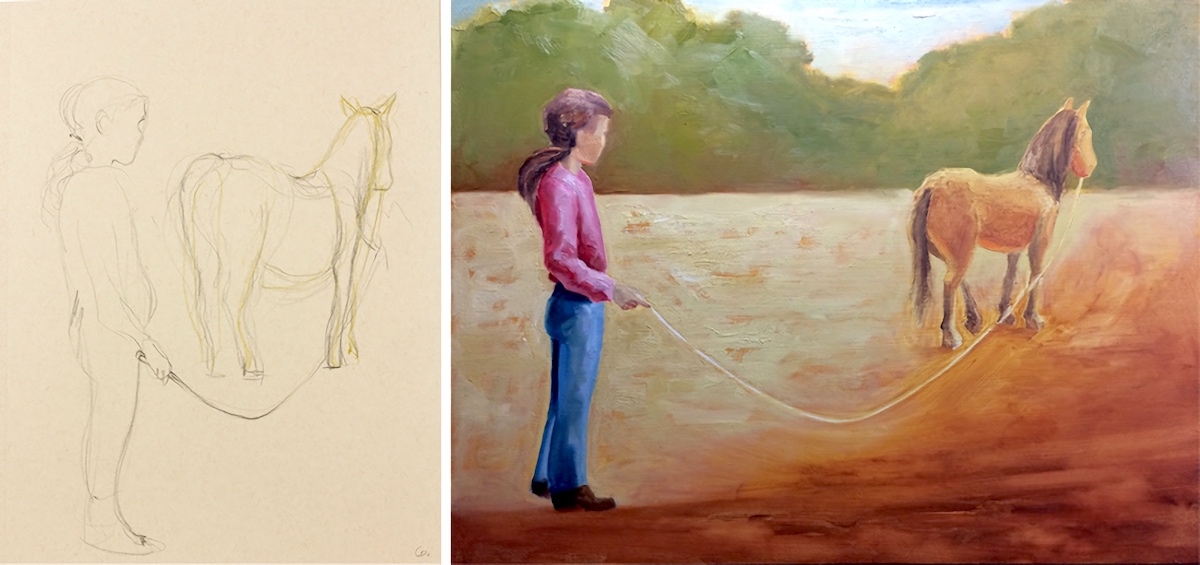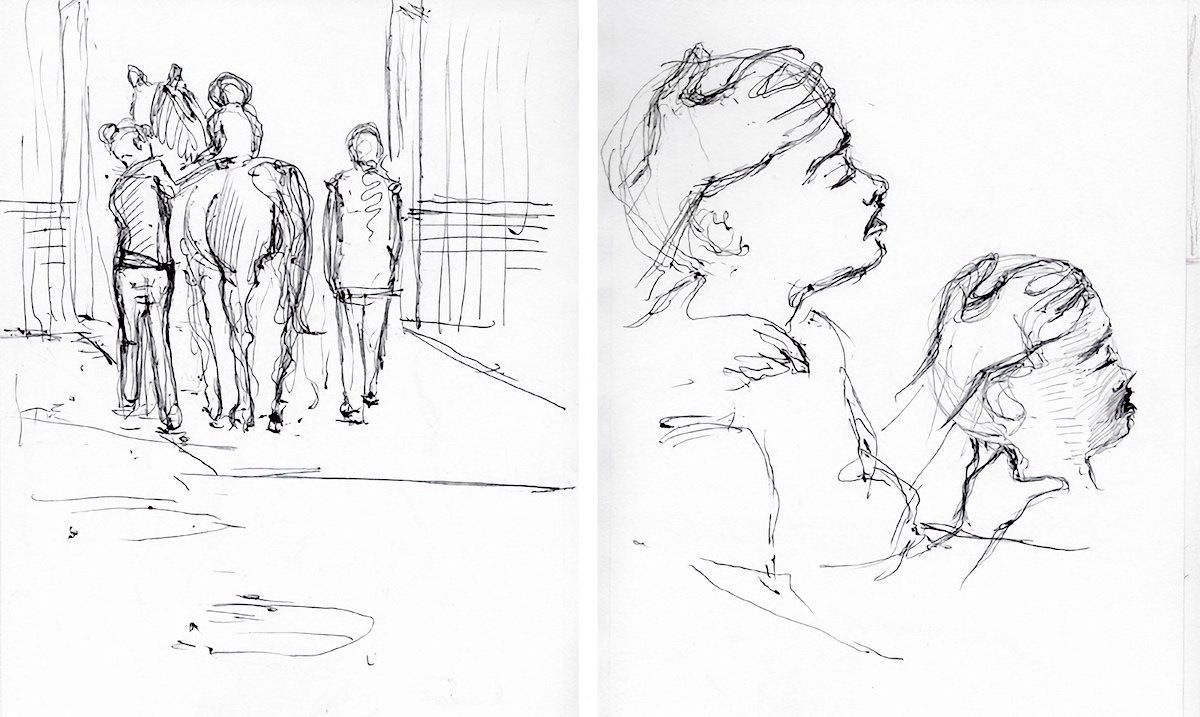Student Blog
Antonietta
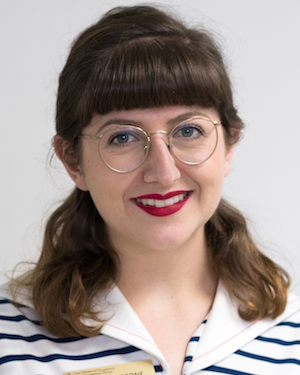
Reflections From My Residency: Using the human animal bond therapeutically ⟩
April 2, 2019, by Antonietta
As I discussed in the previous blog, humans’ perception of our emotional bond with animals started being examined and debated in the mid 1700s. But when did we start to use this bond therapeutically? The earliest report is at the York Retreat, an asylum for the mentally ill, in England 1792 where the inhabitants cared for rabbits and chickens (Netting, Wilson, & New, 1987). This therapeutic strategy took quite a bit longer to make its way to the United States, but starting in the 1940s at Pawling Air Force Convalescent Hospital, veterans were encouraged to work with farm animals as part of their recovery. By the 1970s dogs became a common tool in therapeutic settings: 48% of institutes incorporated them in some way per an American Humane Education Society report. Animals are now well-established as therapeutic partners, used by many disciplines and in variety of ways. But why? History has moved on from so many other treatments of the past. Plunge baths from the 1700s aren’t used anymore and lobotomies — which were very popular in the 1950s — are considered repugnant and deemed unethical. But animal assisted therapy has gotten stronger, more common, and better supported by research. What makes it so effective? Is it the emotional bond between human and animal?
Curious about this therapeutic bond and interested in the power of images to shed light on relationships, my father Carmine, organized a field study at The Children’s Ranch. He came every Friday afternoon for a semester to observe the sessions and sketch what he was seeing. He wanted to know if he could capture the mystery of this therapeutic bond in a visual form: painting.
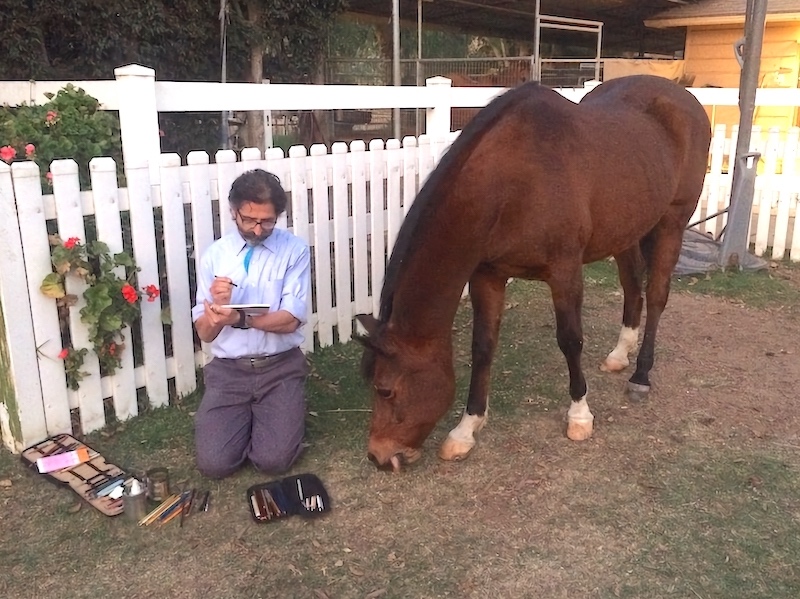
Carmine and Storm
For me as a therapist, it was an interesting experience to have this observer participating in our sessions, but I was curious what it was like for him. Since he’s my dad it was easy to get an interview!
How did you decide how much time you would spend at The Ranch?
“That decision depended on a specific rule I set for myself: my documentation would not employ any cameras; all my observations would be drawn by hand. Using a camera would have sped up the work, but it also would have had a few undesirable side effects.
- Cameras reduce the actual amount of time you need to spend on the ground and therefore can lead to a false illusion of understanding the authentic experience.
- Cameras automatically create a default composition which is hard to modify. In the process, they can eliminate key parts of an experience.
- Cameras make people pose! That was something I wanted to avoid. To see genuine moments, I needed to be integrated as part of the team so that everyone was relaxed and acting naturally.
I needed to spend time on the ground to gather visual data, build relationships slowly, accrue insight, and become a participant. It took about 4 months of consistent visits to get to that point, but I didn’t know that in advance”
What were some of the challenges you encountered?
“One challenge was developing a sketch kit that was completely mobile. Since sessions at the Ranch move around a lot, I needed to be agile and flexible. In a way, I was a member of the team and didn’t want anything to be slowing me down while we transitioned from the chicken coop to the barn. So, every piece of equipment had to be portable and always ready-to-go.
A second challenge was that children are curious, and my tools often piqued their interest. The kids wanted to play with them and once they saw some of the sketches, there was a risk they would be distracted from the work they were doing with the therapist. I had to find the line between engaging them and building our relationship, and redirecting them back to the focus of their time at the Ranch, which was the caring for the animals.
However, the fact that the kids were conscious of being drawn was significant in another way. I’m interested in how these sketches, and eventually the finished oil paintings, might serve as a mechanism for self-reflection for the children. I believe that how we picture ourselves is a big part of our identity formation. When the paintings are exhibited at my studio later this year and everyone is invited to the opening, I am curious how the children and their families will respond to visualizations of themselves participating in really unique and meaningful experiences.”
Talk about your trip to visit me at Skyline Therapy Services in Albuquerque.
“You and I had talked a lot about the differences between Animal Assisted Therapy and Hippotherapy, but it wasn’t until I got to see both that I really understood. Your work at the Ranch grows out of a relationship you foster between the children and the animals. The activities are structured around caring for the animals’ needs and understanding their well-being, as a way for the child to develop their own sense of self, autonomy, and identity as well as any other goals you are working on. From a visual point of view, that kind of relationship is subtle and elusive.
At Skyline, where Hippotherapy is the main treatment tool, it is not about the emotional bond, but the relationship between bodies. For an artist, that kind of spatial relationship is more visible and more direct; you you don’t need to visualize a mood, or a state of mind. With Hippotherapy, it much more physically evident how the therapists are helping and how the child’s body changes before and after their session.”
Now that you have finished your field work and are starting on the oil paintings, do you think you have achieved your goal of visualizing the bond?
“After I finished amassing the sketches my next big challenge was to create compositions for the paintings. These were based not just on the drawings, but also my memory and a kind of intuition that had been created by everything I had seen. The compositions were also determined by basic pictorial conventions and requirements. I know that amounts to a lot of variables. My concern as an artist is that what results might be an interesting picture, but not real documentation. I guess the critical test will be when the kids, therapists, and families see and judge for themselves.”
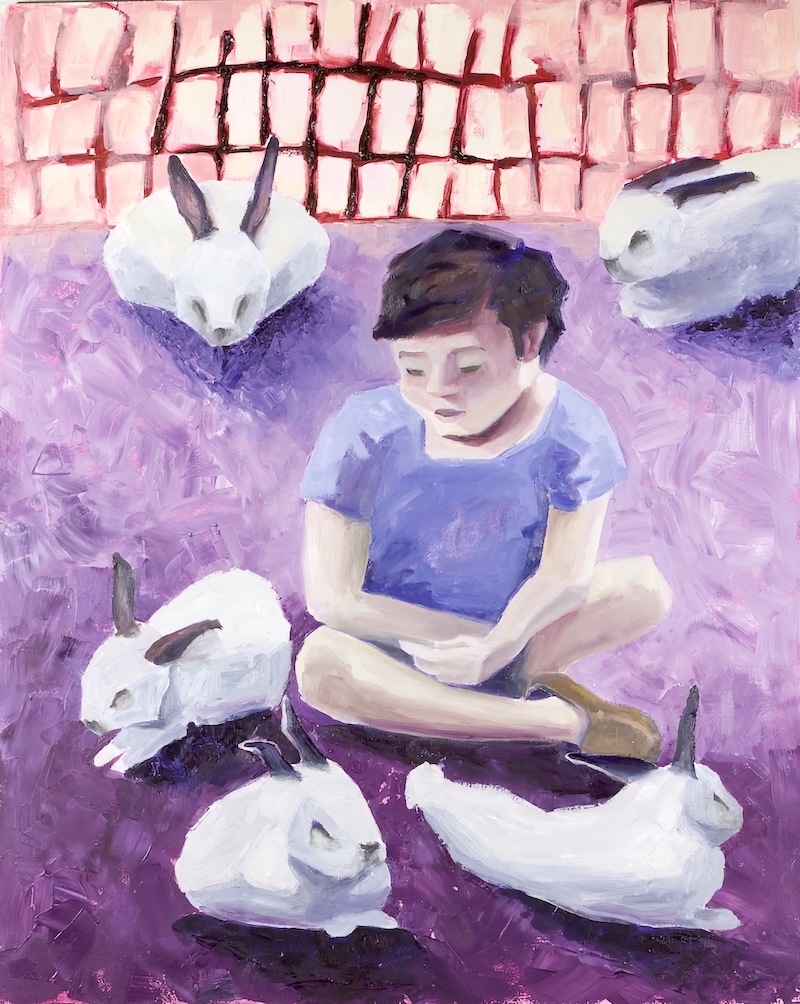
Child with rabbits
When I look at the paintings, I see what looks like my treatment sessions but also feel what it is like the be at the Ranch. It is amazing to see a visual image of that sense of calm when a child with ADHD sits quietly with the rabbits, because that is what makes them feel happy and “green.” It is incredible to see in a permanent form, the fleeting connection between a child and horse that is so strong it can get a kid out of her home despite immense rigidity. I was happy to have an extra member of our team when my dad was visiting the Ranch and I’m very excited to see what my students think of these pictures.
Netting, F. E., Wilson, C. C., & New, J. C. (1987). The human-animal bond: Implications for practice. Social Work, 32(1), 60–64. https://doi.org/10.1093/sw/32.1.60
⋯

Reflections From My Residency: When did we realize that humans and animals have an emotional bond? ⟩
February 12, 2019, by Antonietta
In today’s culture, where people dress their dogs up for Halloween and get baby strollers for their cats, this may seem like a silly question . . . but when did we realize that humans can have an emotional bond with animals? The debate in “pop culture” can be traced back to 1765 when Jean-Baptiste Greuze completed an intricate portrait in oil paints of a young woman and a dead bird (see below). Each component of this painting isn’t odd for the time period, but what stirred the pot was the young woman’s expression. You can see she looks devastated. From our modern perspective, it is obvious this because her darling pet bird died, but in the mid 1700s it was not part of the zeitgeist to think animals were something you could have an emotional bond with. Jean-Baptiste Greuze observed the people around him and started to challenge this assumption with his painting.
![Greuze, J. (1765). A Girl with a Dead Canary [Painting]. Scottish National Gallery, Edinburgh, Scotland.](https://chan.usc.edu/uploads/student-blogs/antonietta-animals-humans-emotional-bond-feb2019-1.jpg)
Greuze, J. (1765). A Girl with a Dead Canary [Painting]. Scottish National Gallery, Edinburgh, Scotland.
This conversation swirled around for about a hundred years and in 1890 Paul Meyerheim added to the next iteration. He painted “The Jealous Lioness” (see below). His challenge was not only that humans and animals can have an emotional bond, but that animals actually have their own emotions. And not just simple emotions like happiness and boredom, but complex ones like jealousy. This painting illustrates the beginning of the big shift to the modern perspective of how we think about animals.
![Meyerheim, P. (1885-1890). The Jealous Lioness [Painting]. Städelscher Museums-Verein, Frankfurt, Germany.](https://chan.usc.edu/uploads/student-blogs/antonietta-animals-humans-emotional-bond-feb2019-2.jpg)
Meyerheim, P. (1885-1890). The Jealous Lioness [Painting]. Städelscher Museums-Verein, Frankfurt, Germany.
Ok, so how do I know all of this? It started one night during a conversation over dinner with my dad. I was feeling pretty beat from work and Papa asked me about my day. We had had a student at The Children’s Ranch who was struggling. He loved our animals but was not able to keep his body calm and safe around them. We had been using a tool with him, a modified zones of regulation meter, to check in with how he was feeling. It was also intended to teach him how to observe our horses and chickens to see how they were feeling. I’d brought home one of our pocket sized, laminated meters by accident and so I pulled it out and showed my dad (see below). He looked quizzical . . . “but if you’re starting the discussion with the animal’s emotions, then why are the faces emoji’s? Why not have drawings of what the horses actually look like when their emotions change?”
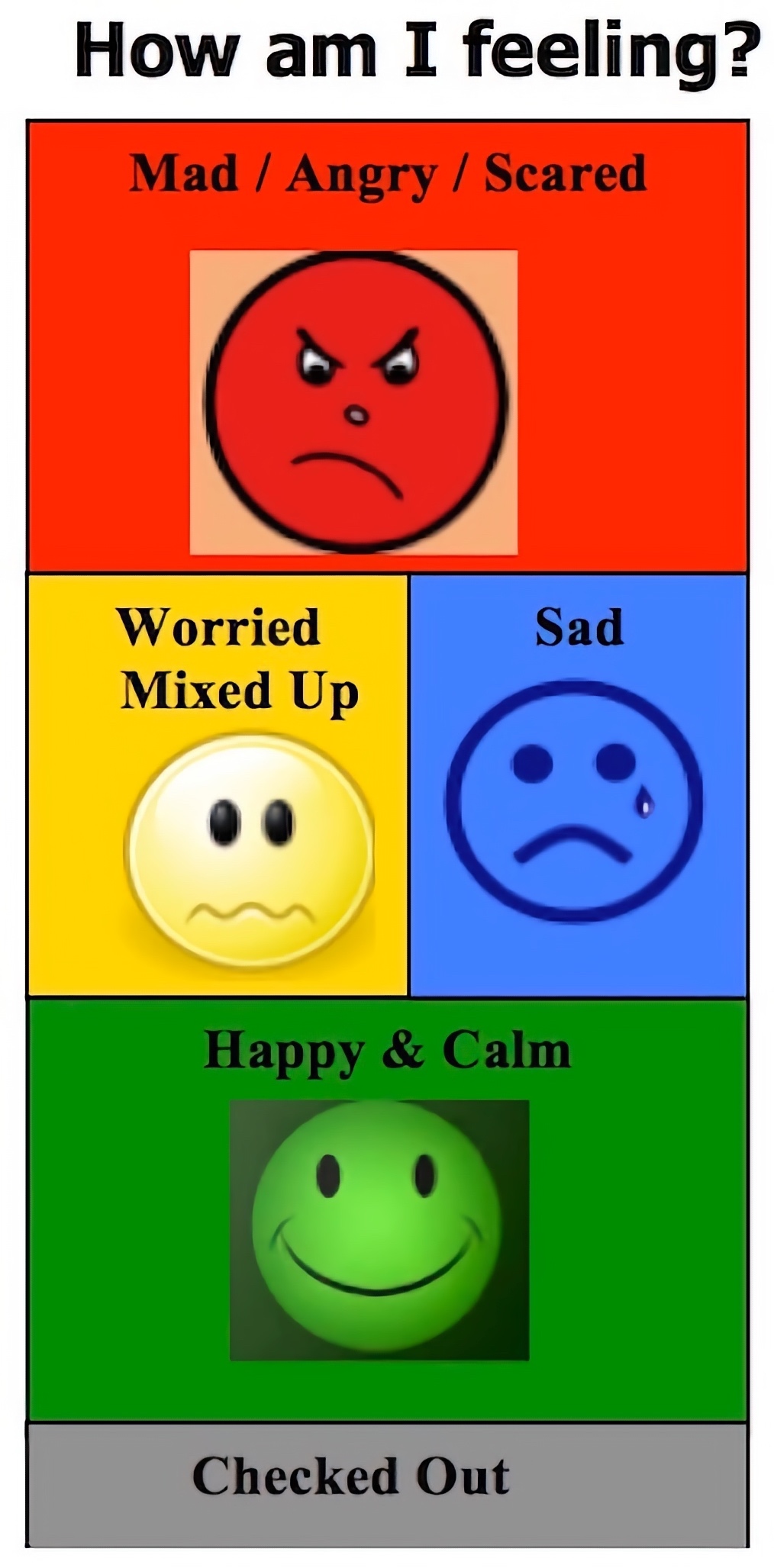
A project was born! My dad (Carmine Iannaccone) is an artist and professor in the Master of Fine Art program at Claremont Graduate University. He is the one who taught me about the two paintings in the beginning of this blog because visual culture is something he studies and is a theme he has been creating artwork around for years. He has this amazing ability to connect almost anything to visual culture, which makes our conversations fascinating and rich. So anyways, the project: a meter which features horses faces showing the different zones. Papa did the drawings, I collated and colored them in Photoshop and now we have a tool which is even more effective than the original (see below). Because humans undoubtedly do have a bond with animals, children are immediately fascinated by the horse meter. When I first show them the little card, they frequently take it right out of my hand to stare at the pictures . . . and then the questions about our horses start rolling in:
“What makes Dove sad?”
“How can I make Storm happy?”
“How can you tell that Pepper is scared?”
“Why is Cody so worried?”
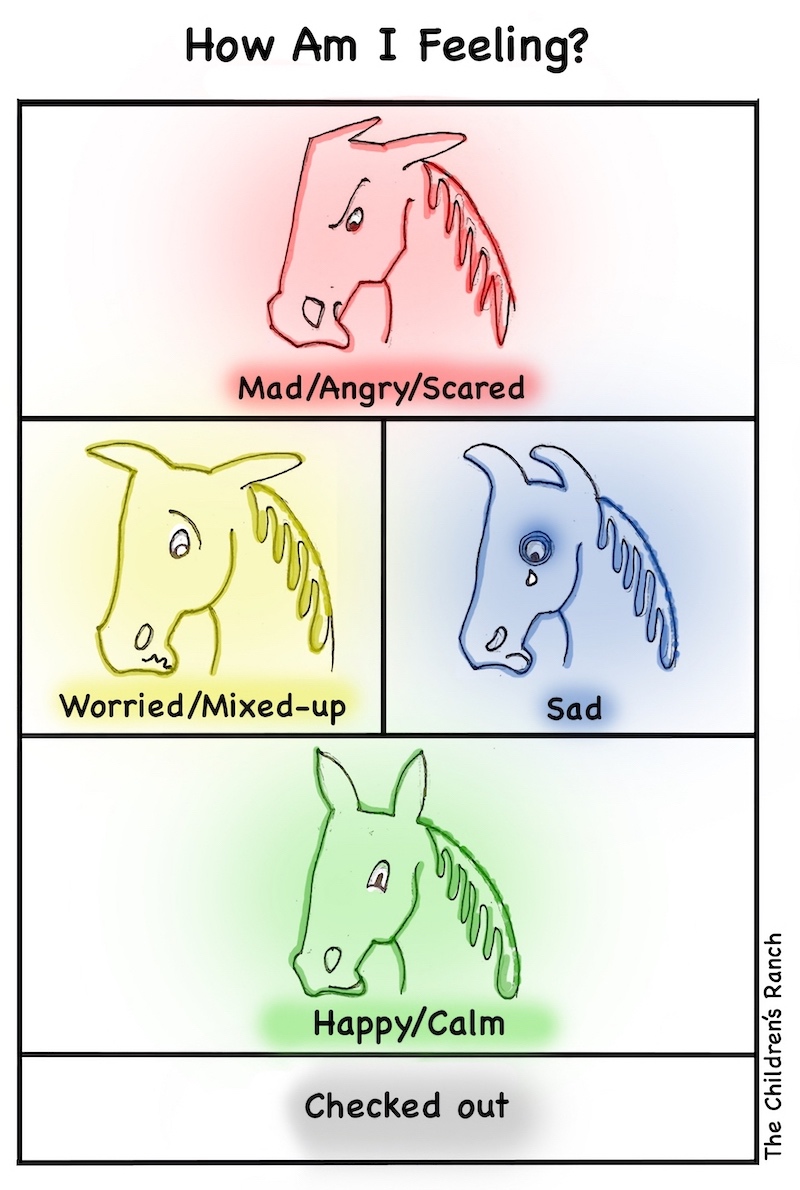
There is always buy-in. The meter flows naturally into and out of our conversations. It is a tool we use together to teach and learn about our animal companions. This collaboration with my dad continued. Inspired by the work of Greuze and Meyerheim (the painters I discussed above), he came to the Ranch every Friday for a semester . . . but more about that in my next post!
⋯

Five ways to make the OTD more affordable ⟩
January 23, 2019, by Antonietta
Like I mentioned in my previous blog Choosing a Residency Site, off the bat it seems like a USC affiliate site is the best financial package and the whole prospect of affording the OTD without it seems impossible. I’m here to tell you that is not the case! Yes, the OTD at USC is expensive but here are five steps I took to make it more affordable:
- The most direct one was finding a residency site that hired me on as an occupational therapist once I got my license. I looked at Glassdoor to get a sense of what entry level pay was like and mine is a few dollars lower because of the mentorship and training that I receive. I can cover about 50% of my Fall/Spring tuition (before any scholarship) by completing 20 hours of residency work per week. This percentage will change over the summer when I’m working full time at my residencies.
- The next one was a question of weighing pros and cons. First the background: in the Master’s you pay a flat rate for 18 units of tuition and for the Doctorate you pay for each unit you take. During the Fall and Spring of the second year of the Master’s you are not required to take the full 18 units and there are opportunities where you could be. In the Fall, you can do Directed Research (OT 590) for 2 units and during the Spring you can load up on elective credits to reach the full 18. Elective credits taken during the Master’s carry over to the Doctorate and if you do the max units both semester you do not need to take any elective during the OTD. This saves you up to 4 units at approximately $1800 per unit. I found 18 units manageable but it was noticeably more work than my classmates who were not doing it . . . so consider that as you plan your semester!
- There are some paid positions in the Division available only to OTD students. I am the classroom assistant for two courses. Since the professors know that you are also a student in an intensive course of study, I have found they are easy to work with and I can adjust my schedule to manage both these positions and my doctoral work. I personally enjoy being connected back to the Master’s program and working with professors that I was inspired by when I was in their classrooms.
- Keeping my grades up! There is scholarship from the Division for the OTD based on academic achievement. This includes GPA as well as participation and impact in the Division during the Master’s.
- Finally, I’ve known since I started the program that I wanted to pursue the OTD, so I did some things to prepare for the expense including working during the Master’s. I picked up 5-7 hours per week and it helped cut down on my expenses during the Master’s which made taking on the financial burden of the additional OTD year slightly less intimidating.
I’m not going to talk about loans or scholarship because it is very similar to the Master’s. There have been some great Ambassador blog posts written about these topics in the past so definitely check those out. I hope that sharing this part of my OTD experience demonstrates that there are ways to make the OTD work financially and for me, it has been worth every penny.
⋯

Choosing a Residency Site ⟩
November 30, 2018, by Antonietta
Thinking back to last year and searching for a residency site . . . I’m still overwhelmed! It is such an important part of the OTD experience but with a little bit of reframing it becomes a much more conquerable task, in fact it becomes as an opportunity to achieve some of your goals.
- First, stop. Take a deep breath. Ok, now . . .
- Reframe how you’re thinking about the search. This is not fieldwork. Your residency will not be like fieldwork and finding your site will not be like getting assigned a fieldwork placement. In fact, you are 100% in charge!
- I found it useful to think of the process like a job search. You want to consider the obvious things like the practice area but you have the freedom to include the following in your considerations: the work environment, the length of your commute, the flexibility in the hours you’ll work, and what your pay will be.
- You will probably have to reach out to more than one site . . . probably more than two . . . I have a friend who approached more than 15. But they found a spot in the advanced practicing setting they wanted and they got it and they’re so excited about it. The leg work was worth it.
- Remember the timeline for securing a residency. I didn’t start reaching out to sites until the Spring and I did not have mine confirmed until the middle of the Summer. I was too busy early in the second year of the Master’s to tackle the search and I was not put at a disadvantage by waiting until I had time to do it right. You don’t need to have your site confirmed until the beginning of your OTD.
- Many sites will interview you, take this as an opportunity to interview them right back! This is going to be the place where you blossom from an entry level practitioner to an established therapist. You want to advocate for what you’ll need and make sure the site you’re going for can provide it.
- Expand your search beyond the USC affiliated sites. These sites are amazing and might seem like an easy fix to all the anxiety about finding a residency . . . but they are not the right fit for everyone. Even if they’re in the practice area or population that you are interested in, the management style or location or required projects might not be right for you. Consider these things and know that there are many other sites available. Another reason people apply exclusively for the USC sites is because of funding. I will write another blog post on this soon, but there are other ways to fund the OTD with a similar financial obligation.
- Consider all the tracks. I ended up going with the clinical route but I have friends who want to be clinicians but took this opportunity to expand their skills in research or policy and administration. It was not necessarily their original plan but they seized the opportunity offered to them and are learning a lot. An interview with some of them will be available soon, make sure to check it out!
- Talk to potential faculty mentors. I didn’t come up with my residency structure until I talked to Dr. Blanche about my goals.
- Claim the experience, decide what you want, and make it work for you. It can be sort of flexible, so mold it. I had two interested (sensory integration and animal assisted therapy) so I’m doing a split residency between two sites. I do 10 hours per week at Therapy West and 10 hours at The Children’s Ranch and this is the right balance for me. This is YOUR residency and you have the power to make it what you need!
I’m happy to talk to anyone who has more questions, please feel free to reach out.
⋯

To do, or not to do . . . the OTD ⟩
November 27, 2018, by Antonietta
With OT moving in the direction of an entry level doctorate, you might be one of the last groups of OTs deciding whether to elect to pursue the D! I obviously chose to, but I still considered a number of things. Some were more practical, like I knew it was unlikely that I would come back to school for a third time to do it later and I qualified for the accelerated acceptance to USC’s program with advanced standing. But some were more esoteric. Reflecting on the experience of making that decision, I created a list of things I considered. I did not have specific answers to each one, but I was excited about this type of question.
- What practice area or deep interest would you like to focus on during this experience? Remember a practice area can be a clinical setting but also research, policy, administration, program development, or education.
- Does doing projects like a literature search about the population needs and best practices in the area of your proposed residency excite you?
- Are you interested in current issues in OT and critically problem solving how to address them?
- Are you interested in blazing the trail for the future of occupational therapy and being a leader in the field?
- What sort of experience do you want your residency to be and what are you hoping to get from it as well as from your faculty mentor at USC?
Doing the OTD at USC differentiates your level of commitment to your education. It will set you apart from other applicants because you will have gained above entry level clinical skills, done in depth work in an advance practice area, developed a meaningful program, done ground breaking research, contributed to discussions around policy and administration, and/or developed your skills to educated the next generation of occupational therapists. You will have honed your leadership skills and be set on the path to be a leader in our field.

⋯







